#Santo Domingo de la Calzada Cathedral
Text




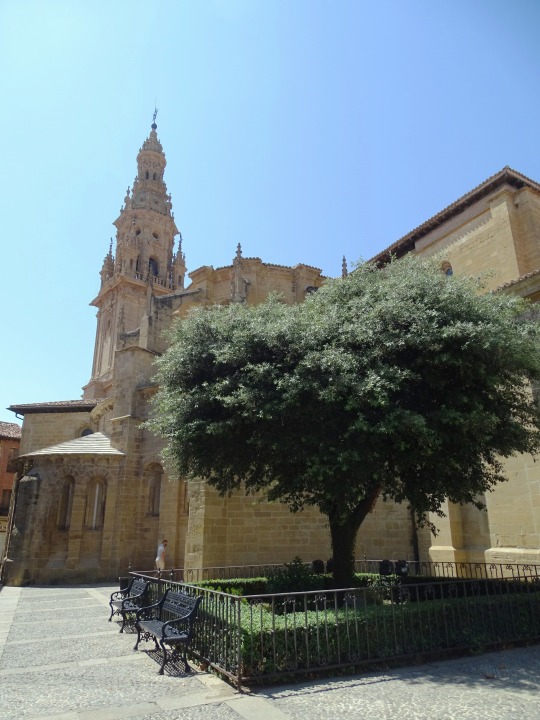


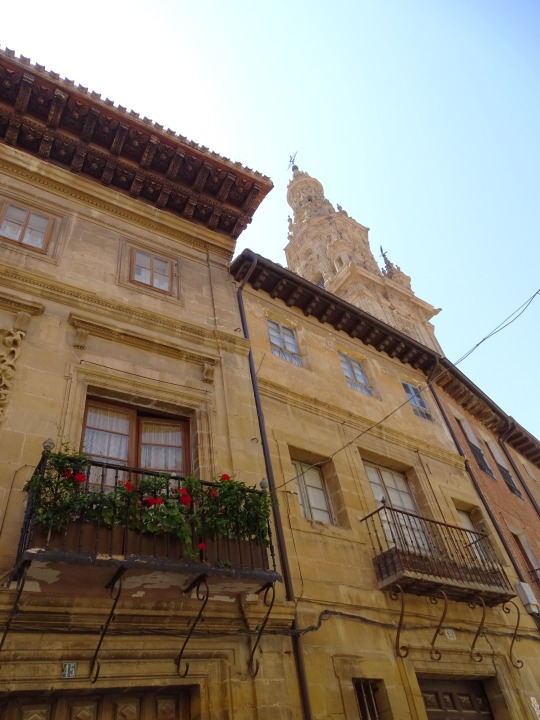

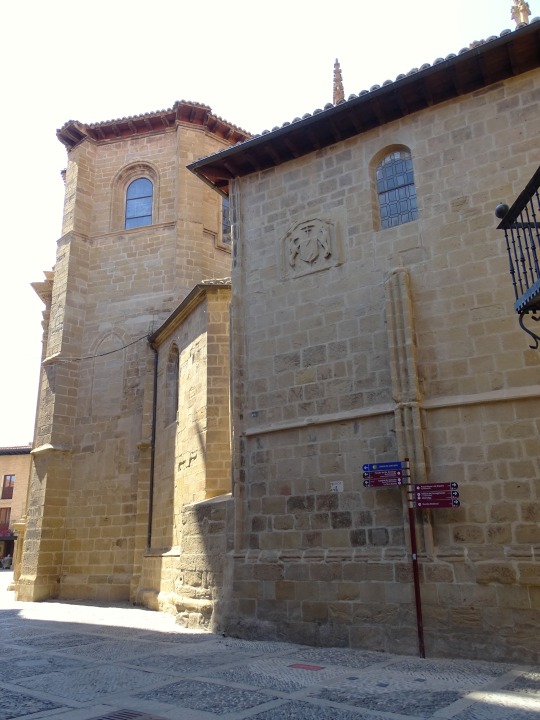
Cathedral of Santo Domingo de la Calzada, Spain (No. 2)
The building that is now contemplated as the co-cathedral of Santo Domingo de la Calzada is, really, an amalgam of different styles ranging from the Romanesque of its head to the baroque of its genuine free-standing bell tower, passing through its body of naves, which can be classified as fully Gothic. To all this we must add the different reforms and extensions that it suffered during the Modern Age as a result of restorations, collapses or, simply, by the changes that each bishop was making to adapt the see to the tastes and fashions of each historical moment.
Several modifications were made to the original plant, adding:
in the thirteenth and fourteenth centuries: the naves, defenses and portico of the west façade;
in the fifteenth and sixteenth centuries: the chapels of the apse, of the Immaculate and the two in sections 2 and 3 of the south façade;
in the seventeenth century the baptistery of the section of the feet;
in the eighteenth century, the south portal;
the tower, original of the twelfth century, was rebuilt in the fifteenth and eighteenth centuries; the latter in the current location.
Source: Wikipedia
#Santo Domingo de la Calzada Cathedral#Cathedral of Santo Domingo de la Calzada#Santo Domingo de la Calzada#La Rioja#Northern Spain#España#original photography#vacation#travel#tourist attraction#landmark#cityscape#architecture#summer 2021#pedestrian zone#old town#Way of St. James#Camino Frances to Santiago#Camino de Santiago
10 notes
·
View notes
Text

Cristo en la cruz con dos dolientes, talla de piedra medieval, catedral, Santo Domingo de la Calzada, La Rioja, 2012.
#architectural sculpture#christ#mourners#cathedral#santo domingo de la calzada#la rioja#2012#photographers on tumblr#camino francés#camino santiago
5 notes
·
View notes
Photo
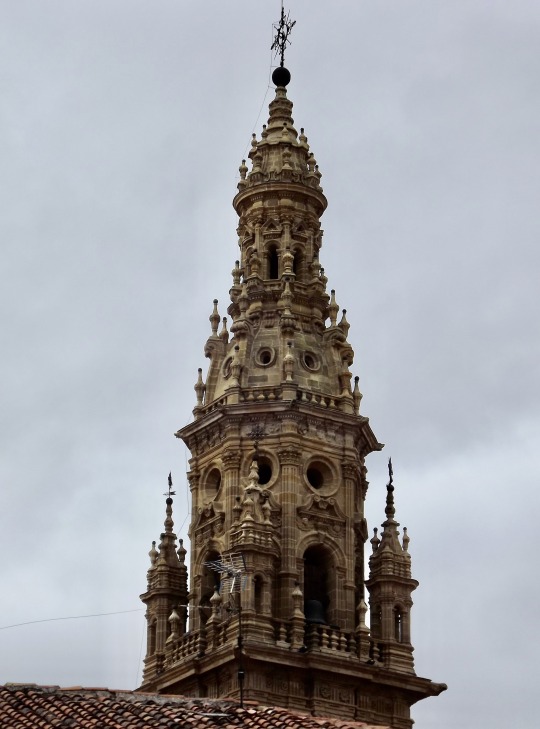
Torre, catedral, Santo Domingo de la Calzada, 2011.
#tower#cathedral#santo domingo de la calzada#la rioja#españa#2011#photographers on tumblr#camino francés#camino santiago
4 notes
·
View notes
Text
Day 12 - Najera to Santo Domingo de la Calzada
The Guide Book says today was 13.2 miles, but we made a small diversion for lunch and my phone says 14.5 miles.
We had our bags transferred today so travelled light. As we walk more days the pads of our feet are getting a bit sore and the rucksack feels heavier and heavier! It’s really easy to have it transferred, most albergue’s have envelopes belonging to the carriers which you attach to your rucksack. You need to have somewhere reserved to send it to, and I have been doing all the booking online.
Anyway, back to today…We set off as usual at 7:30 in overcast weather with the odd spot of rain. Within half an hour we had our ponchos on but it never got more than a bit drizzly.
We climbed out of the town through some forestry passing an odd statue of Jesus up on the hill. The hillside, path, rocks and land in general is very red in this part.


There were plenty of vineyards to admire, some being very well kept with guys at the side of the path strimming the weeds away. The above ground irrigation system was interesting to see.


We were making for Azofra for breakfast, about 4 miles away. Breakfast was the usual coffee, orange juice and pain au chocolat. But to be honest the novelty is now wearing off and we’re thinking of other things that we could have instead.
The lunch stop was about another 6 miles away so we plodded on. Our lives are defined by how far away the villages are for breakfast, lunch and final destination!
The landscape initially wasn’t particularly pretty, the path passing by the side of a motorway, but it soon turned inland and we were once again rewarded by huge open fields, reverting back to the chalk path, deep green barley fields, yellow rape fields and poppies by the pathway. The weather cleared up, the sun came out, and we had some amazing views either side to the hills and mountains.

As we approached Ciruena, our lunch stop, we initially went through what looked like a golf resort, with modern seemingly empty houses, a golf course and swimming pool. It all looked a bit out of place and odd.

We diverted off the waymarked path into Ciruena village to the local bar for a welcome drink (Jane had freshly squeezed orange juice and I the local lemonade that I have become very attached to) and a warm tuna, cheese and egg roll.
After lunch we carried on through the open landscape finally reaching Santo Domingo shortly after 2.


We’re in an ancient very large albergue right in the middle of the old town. Our room is in the old part of the hostel up in the eaves. All bar one of the beds are single beds, it’s like an old school dorm!
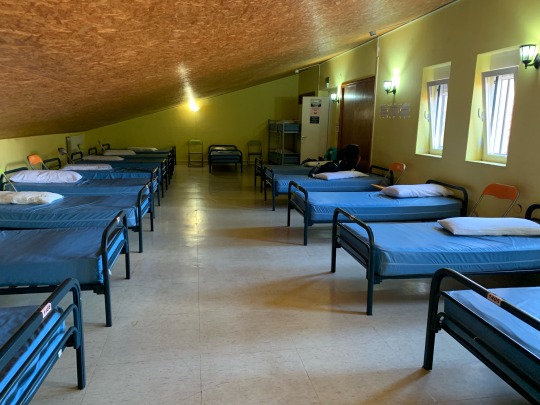
I chilled until 5 while Jane went for a wander, then we both went to see the cathedral. It’s huge and they have done a good job inside of making sure everything is explained very well.

We had a Pilgrim’s menu in the square then went to find the supermarket for a few bits. On the way we passed groups of youngsters practicing for a dance competition and it was great to watch them.
Now we’re back and chilling, and hoping we’ll get some sleep. Tomorrow is a very short day so hopefully we can snooze in the afternoon.
10 notes
·
View notes
Text
Day 9: Nájera to Santo Domingo de la Calzada, 21.3 km
213 km total, 27.4%
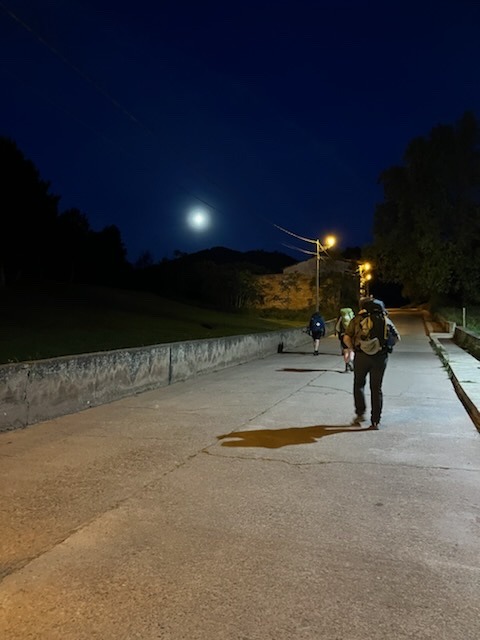
I think today marked a bit of a shift for mom. She seems to have gotten past the transition of getting started and is settling into her rhythm, getting more confident, and finding deeper joy in the path.

She got an early start with the moon on one side and the sunrise on the other.
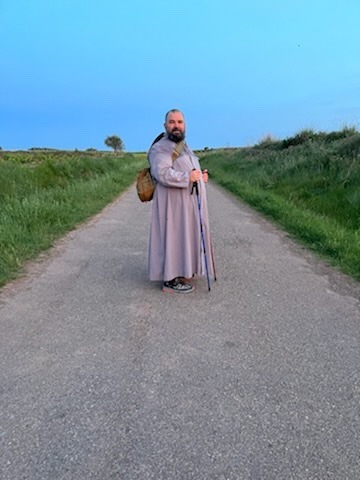

The cathedral she visited this evening has an interesting history that includes chickens. You’ll want to read this one for yourself!
Dominic de la Calzada - Wikipedia
Dominic de la Calzada - Wikipedia
EN.WIKIPEDIA.ORG
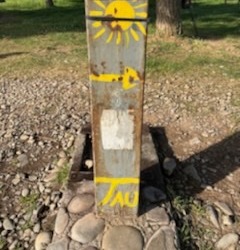
Buen camino!
2 notes
·
View notes
Text
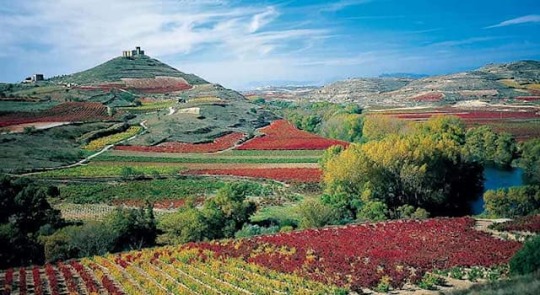
The province of La Rioja is in which country?
The province of La Rioja, located in northern Spain, is a region famous for its red wines, which are made primarily from the Tempranillo grape variety. The capital of the province, Logroño, serves as the gateway to the La Rioja wine region.
Beyond Logroño, La Rioja is dotted with towns, such as Haro, which is home to some of the oldest wineries in the region. The town also hosts the 'Batalla del Vino' (Wine Battle) festival in June. Another town, Briones, is home to the Vivanco Museum of Wine Culture, which showcases the history and culture of wine.
The town of Santo Domingo de la Calzada is famous for its cathedral, which houses the remains of the town's patron saint. The cathedral is also known for its unique feature - a live rooster and hen that are kept in the church as a symbol of a miracle that occurred in the 14th century. The Sierra de Cebollera Natural Park is also located in La Rioja.
0 notes
Text
Spain's hidden gems - Photographing the lesser-known luxury destinations
Discovering Spain's Underrated Luxury Destinations
When planning a luxury vacation in Spain, most visitors tend to flock to the popular destinations such as Madrid, Barcelona, and Ibiza. However, there are many underrated luxury destinations in Spain that offer just as much charm, culture, and luxury as the popular ones. In this section, we'll take a look at some of these hidden gems.
San Sebastian
San Sebastian is a charming coastal city located in the Basque Country. It boasts stunning beaches, Michelin-starred restaurants, luxurious spas, and hotels. One of the most popular places to stay in San Sebastian is the Hotel Maria Cristina, which has hosted celebrities such as Woody Allen and Elizabeth Taylor. Don't forget to try the famous pintxos (Basque tapas) while you're there!
La Rioja
La Rioja is a region known for its wine. It's home to some of the best wineries in Spain, as well as luxurious hotels such as the Marqués de Riscal, designed by architect Frank Gehry. Apart from wine tourism, La Rioja also offers stunning landscapes, monasteries, and charming medieval towns like Santo Domingo de la Calzada.
Segovia
Segovia is a UNESCO World Heritage Site located just an hour away from Madrid. It's home to many historic landmarks such as the Roman Aqueduct, the Alcázar of Segovia, and the Gothic Segovia Cathedral. Segovia is also known for its traditional cuisine, including the famous cochinillo (roast suckling pig), which you can enjoy in many of its luxury restaurants, such as the Cándido Restaurant.
Costa Brava
The Costa Brava is a stunning coastal area in Catalonia, located just an hour away from Barcelona. It's home to some of the most beautiful beaches in Spain, including Sa Conca and Platja d'Aro. The Costa Brava also offers luxurious hotels such as the Hotel Sant Pere del Bosc, which features a stunning spa and Michelin-starred restaurant.
Capturing the Charm of Secluded Beach Towns
One of the best things about Spain is its stunning coastline. From the Mediterranean to the Atlantic, there are countless beaches to discover, many of which offer a more secluded and peaceful setting than the busy tourist destinations. These lesser-known towns offer a perfect setting for capturing charming and unique photographs, showcasing the natural beauty of the coast and the local culture. Here are some key tips for capturing the charm of secluded beach towns:
1. Research and Explore
The first step to capturing the charm of a secluded beach town is to explore the area and get a sense of the local culture. Take a walk through the town, talk to the locals, and observe the daily routines. This will help you find the best spots for photography, as well as add depth and authenticity to your images.
2. Use Natural Light
One of the most important things to consider when photographing beach towns is lighting. Opt for natural light whenever possible, especially during the golden hour (just after sunrise and before sunset). This will provide a soft and warm glow to your images, bringing out the natural beauty of the coastline, architecture, and people.
3. Capture Local Flavor
When photographing a beach town, be sure to capture the local flavor. This means including images of local cuisine, architecture, and cultural traditions. Showcasing the unique characteristics of the town will not only make your images more interesting but also help to capture the charm of the area.
4. Focus on Details
Don’t forget to focus on the details when photographing a beach town. Small details such as colorful doors, worn cobblestone streets, and unique signage can add depth and interest to your images. Remember, it’s the details that make a place memorable and unique.
5. Experiment with Angles and Perspectives
Finally, when photographing a beach town, be sure to experiment with different angles and perspectives. This means playing around with height and distance, as well as trying out different lenses and camera settings. This will help you capture the town from unique and interesting perspectives, bringing a fresh and creative approach to your images.
By following these tips and taking the time to explore and observe, you can capture the charm of secluded beach towns and create stunning and unique images that showcase the natural beauty and local culture.
Exploring the Picturesque Countryside Villages
If you're looking to escape the hustle and bustle of Spain's cities and tourist hotspots, why not venture into the picturesque countryside villages that are brimming with breathtaking landscapes and culture? Here are some of the lesser-known yet equally luxurious destinations that you can photograph and explore:
Valldemossa, Mallorca
Tucked away in the Tramontana mountains, Valldemossa is a charming village that has captured the hearts of artists and writers for centuries. Its narrow streets and stone buildings offer a glimpse into traditional Mallorcan life, while its historical landmarks, such as the 13th-century Carthusian Monastery, showcase the island's rich culture.
Guadalest, Costa Blanca
Perched on a mountaintop, Guadalest is a medieval village that is known for its stunning views of the surrounding valleys and reservoirs. Its narrow streets are lined with artisan shops that sell handmade crafts and souvenirs, and its castle and museums offer visitors a glimpse into the region's history.
Ronda, Andalucia
Situated on a high plateau, Ronda is a charming village that is steeped in history and culture. Its most famous landmark is the Puente Nuevo bridge, which spans a dramatic gorge and offers breathtaking views of the surrounding mountains. Visitors can also explore the village's historical landmarks, such as the bullring and Moorish palace, and sample the local cuisine at traditional tapas bars.
Cadaques, Catalonia
Nestled on the Costa Brava, Cadaques is a picturesque fishing village that has attracted artists and bohemians for decades. Its charming cobbled streets and whitewashed houses offer a glimpse into traditional Catalan life, while its beaches and crystal-clear waters make it a popular destination for swimming and water sports. Visitors can also explore the village's Dali museum, which showcases the works of the famous surrealist artist.
Exploring the countryside villages of Spain is a great way to discover the country's hidden gems and capture some stunning photographs. Whether you're interested in history, culture, or natural beauty, these villages offer something for everyone. So why not venture off the beaten path and discover the true beauty of Spain's countryside?
Uncovering the Hidden Gems of Spanish Islands
Spain's islands are a treasure trove of stunning landscapes, fascinating history and quirky culture. Here are some of the lesser-known gems of Spain's islands:
El Hierro, the smallest of the Canary Islands
El Hierro is a paradise for hikers, with its rugged coastline, dense forests and mountain trails. Its history is equally fascinating, with mysterious ancient rock carvings and traditional architecture. The island's star attraction is the Sabinar forest, where gnarled juniper trees twist and turn in the wind.
La Gomera's natural amphitheatre
La Gomera is a unique island shaped like a giant amphitheatre. The Garajonay National Park is the island's highlight, with its dense, humid forests filled with rare species of plants and animals. The park is also home to the iconic Roque de Agando, a volcanic rock formation that towers over the landscape.
Ibiza's hippy heritage
Ibiza is renowned for its vibrant nightlife, but there's more to this island than just parties. Its hippy heritage is still present in the form of markets, where you can pick up handmade crafts and clothing. The island is also dotted with ancient Phoenician ruins and Moorish architecture, adding to its charm.
Menorca's wild coast
The rugged coastline of Menorca is a sight to behold, with its dramatic cliffs, hidden coves and turquoise waters. The island is also home to the S'Albufera des Grau Natural Park, a wetland reserve teeming with birdlife. To fully appreciate the island's natural beauty, take a hike along the Cami de Cavalls, a trail that circles the entire island.
These hidden gems of Spain's islands are waiting to be discovered. Whether you're a nature lover or a history buff, there's something for everyone in these lesser-known luxury destinations.
Immersing Yourself in the Culture of Small Towns
Why Visit Small Towns?
When traveling to Spain, don't just stick to the big cities and tourist hotspots. Small towns offer a more authentic experience of Spanish culture, as well as stunning scenery and unique local traditions. The charm and character of these towns will make you feel like you're stepping back in time.
How to Immerse Yourself in Small Town Culture
To truly immerse yourself in the culture of small towns, be open to trying new things and exploring. Attend local festivals and events, indulge in traditional food and drink, and strike up conversations with locals. Take a stroll through the town's historic streets and admire the architecture. Participate in activities such as wine tasting, hiking, or even horseback riding.
The Benefits of Immersing Yourself in Small Town Culture
By immersing yourself in the culture of small towns, you gain a deeper understanding and appreciation of the local way of life. You'll also create lasting memories and connections with the people you meet. Small towns offer a slower pace of life, which can be a welcome break from the hustle and bustle of big cities.
Examples of Small Towns to Visit in Spain
Some of the best small towns to visit in Spain include Ronda, with its stunning views and historic bullring; Frigiliana, known for its charming white-washed buildings and narrow streets; and Cadaqués, a picturesque seaside town beloved by artists such as Salvador Dali. Don't forget to bring your camera to capture the unique beauty of these hidden gem destinations.
In Conclusion
Immersing yourself in the culture of small towns can be a truly rewarding experience. Don't be afraid to step off the beaten path and explore the lesser-known destinations in Spain. You'll be rewarded with breathtaking scenery, authentic cultural experiences, and memories to last a lifetime.
Photographing the Authentic Spanish Gastronomy
Introduction
Spain is an undisputed paradise for food lovers, and no visit is complete without sampling its rich and diverse gastronomy. From the famous paella and tapas to lesser-known regional specialties, Spanish cuisine is a feast for the senses. As a photographer, capturing the authenticity of Spanish cuisine through the lens can be a rewarding and challenging experience. In this section, we'll explore some tips and tricks for photographing the best of Spanish gastronomy.
Lighting
Good lighting is critical when photographing food, and Spanish cuisine is no exception. Bright, natural light is ideal for capturing the vibrant colors and textures of Spanish dishes. When photographing in restaurants or indoors, try to position your subject near a window or another source of natural light. Avoid using flash or harsh artificial lighting, which can make food look dull and unappetizing.
Presentation
Spanish cuisine is not only known for its delicious flavors but also for its exquisite presentation. To showcase this, be mindful of the composition of your photographs. Consider the arrangement of the dishes, the colors of the food, and any accompanying elements like cutlery or garnishes. Experiment with different angles and perspectives to highlight the unique qualities and details of each dish.
Local Ingredients
One of the defining characteristics of Spanish cuisine is its use of locally sourced and seasonal ingredients. Highlighting the origins of each dish can add another layer of authenticity to your photographs. When photographing Spanish cuisine, try to include the ingredients that make each dish unique, from the fresh seafood of the coast to the olives of the countryside.
Culture
Spanish cuisine is not only about the food itself, but also its cultural significance. Including elements of the local culture in your photographs can add depth and context to your images. Consider photographing the preparation of the food, the atmosphere of the restaurant or market, or the people enjoying the cuisine. These details can help tell a more complete story of Spanish gastronomy.
In conclusion, photographing authentic Spanish cuisine is a delightful challenge that requires a keen eye for detail and an appreciation for the vibrant culture and regional specialties. With these tips and tricks, you can capture the essence of Spanish gastronomy through your lens and create unforgettable images.
Finding Tranquility in Off-the-Beaten-Path Retreats
Escape the Crowds
Spain’s hidden gems offer a luxurious retreat from the hustle and bustle of touristy destinations. For travelers seeking tranquility and serenity, off-the-beaten-path retreats can be the perfect option. Escape the crowds and enjoy a one-of-a-kind vacation experience.
Nature's Lullaby
Nature can be an excellent source of relaxation, and Spain is home to several scenic routes filled with diverse landscapes. Explore the magnificent countryside and let nature's lullaby calm your senses. Take a stroll through the hills, go bird watching, or take a dip in a natural pool.
Peaceful Accommodations
From quaint cottages to luxurious villas, Spain has no shortage of peaceful accommodations. Stay in a retreat located in the middle of a tranquil forest, or in a secluded beach house with spectacular views of the ocean. These unique and secluded lodgings offer the perfect escape from the hustle and bustle of daily life.
Wellness Activities
Off-the-beaten-path retreats in Spain offer a variety of wellness activities such as yoga, meditation, Pilates, and spa treatments. These activities are designed to help you relax, recharge, and rejuvenate. Attend a yoga retreat in the Pyrenees Mountains or indulge in a relaxing spa treatment in the Balearic Islands.
Delicious Cuisine
Spain is known for its delicious cuisine, and these hidden gems are no exception. Enjoy fresh and locally sourced ingredients in dishes that are bursting with flavor. Many retreats offer culinary experiences where guests can learn the art of Spanish cooking and indulge in a delicious meal made from scratch.
For those seeking tranquility and relaxation, Spain’s hidden gems offer the perfect vacation experience. Whether you’re looking to escape the crowds, immerse yourself in nature, or indulge in wellness activities and delicious cuisine, off-the-beaten-path retreats provide a luxurious and peaceful getaway. Experience Spain's hidden gems and find your peace and tranquility in one of the most beautiful countries in the world.
If you're looking for photographic inspiration during your stay, look no further than Capturing the Charm of Luxury Travel in Santorini Through Photography.
Read the full article
0 notes
Text
30 Days Walking Plan to Camino Santiago starting in France:
Day 1: Arrive in Saint-Jean-Pied-de-Port, France
Explore the town and prepare for the start of the Camino
Day 2: Saint-Jean-Pied-de-Port to Roncesvalles (24km)
Start walking through the Pyrenees Mountains and cross the border into Spain
Day 3: Roncesvalles to Zubiri (22km)
Walk through the beautiful Basque countryside and enjoy the views
Day 4: Zubiri to Pamplona (20km)
Walk through picturesque villages and arrive in the lively city of Pamplona
Day 5: Rest day in Pamplona
Explore the city and take a break from walking
Day 6: Pamplona to Puente la Reina (23km)
Walk through vineyards and farmland and arrive in the medieval town of Puente la Reina
Day 7: Puente la Reina to Estella (21km)
Walk through scenic hills and forests to the charming town of Estella
Day 8: Estella to Los Arcos (21km)
Walk through vineyards and fields and arrive in the historic town of Los Arcos
Day 9: Los Arcos to Logroño (28km)
Walk through olive groves and arrive in the bustling city of Logroño
Day 10: Rest day in Logroño
Explore the city and relax
Day 11: Logroño to Nájera (28km)
Walk through rolling hills and arrive in the town of Nájera, known for its monasteries and churches
Day 12: Nájera to Santo Domingo de la Calzada (21km)
Walk through small villages and arrive in the town of Santo Domingo de la Calzada, known for its cathedral and pilgrim's hospital
Day 13: Santo Domingo de la Calzada to Belorado (22km)
Walk through vineyards and fields and arrive in the town of Belorado
Day 14: Belorado to Burgos (36km)
Walk through the Meseta region and arrive in the historic city of Burgos
Day 15: Rest day in Burgos
Explore the city and take a break from walking
Day 16: Burgos to Hontanas (31km)
Walk through the vast plains of the Meseta and arrive in the small village of Hontanas
Day 17: Hontanas to Boadilla del Camino (28km)
Walk through wheat fields and arrive in the charming village of Boadilla del Camino
Day 18: Boadilla del Camino to Carrión de los Condes (24km)
Walk through the rolling hills of the Meseta and arrive in the town of Carrión de los Condes
Day 19: Carrión de los Condes to Terradillos de los Templarios (26km)
Walk through the vast plains of the Meseta and arrive in the village of Terradillos de los Templarios
Day 20: Terradillos de los Templarios to El Burgo Ranero (24km)
Walk through the flat landscape of the Meseta and arrive in the small village of El Burgo Ranero
Day 21: El Burgo Ranero to León (36km)
Walk through the Meseta and arrive in the historic city of León
Day 22: Rest day in León
Explore the city and take a break from walking.
Day 23: León to Villadangos del Páramo (22km)
Walk through the vast plains of the Meseta and arrive in the small town of Villadangos del Páramo
Day 24: Villadangos del Páramo to Astorga (28km)
Walk through the flat landscape of the Meseta and arrive in the historic city of Astorga, known for its Roman ruins and Gothic cathedral
Day 25: Astorga to Foncebadón (27km)
Walk through the picturesque countryside and arrive in the small village of Foncebadón
Day 26: Foncebadón to Ponferrada (26km)
Walk through the mountains and arrive in the historic town of Ponferrada, known for its castle and medieval architecture
Day 27: Ponferrada to Villafranca del Bierzo (24km)
Walk through scenic hills and arrive in the town of Villafranca del Bierzo, known for its historic architecture and wineries
Day 28: Villafranca del Bierzo to O Cebreiro (28km)
Walk through the mountains and arrive in the small village of O Cebreiro, known for its traditional Galician architecture
Day 29: O Cebreiro to Triacastela (21km)
Walk through the stunning countryside and arrive in the small town of Triacastela
Day 30: Triacastela to Santiago de Compostela (20km)
Walk the final leg of the Camino and arrive in Santiago de Compostela, the end point of the journey and home to the Cathedral of Santiago de Compostela, where pilgrims traditionally receive their certificate of completion.
This 30-day travel and walking plan for Camino Santiago starting from France covers approximately 760 kilometers of the Camino, passing through breathtaking landscapes and historic towns and cities. It is important to note that this plan can be adjusted to fit the individual's pace and preferences, and it is recommended to consult with a medical professional before embarking on any long-distance walking journey.

0 notes
Photo
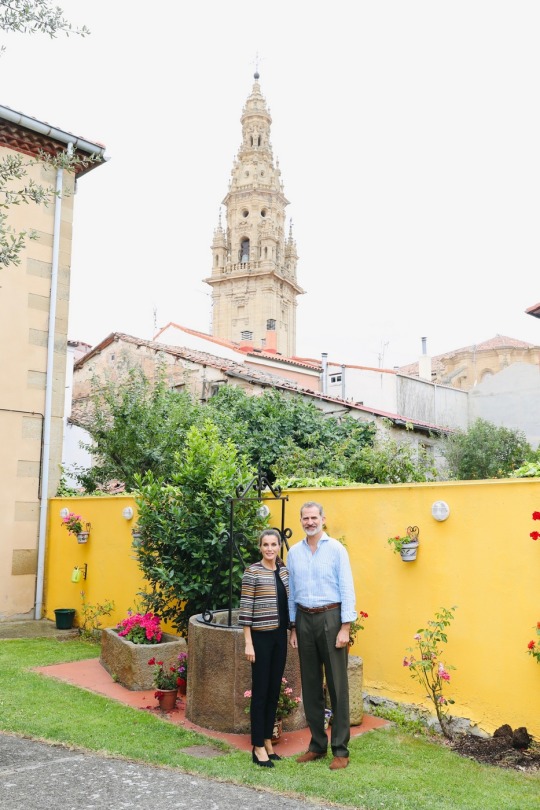

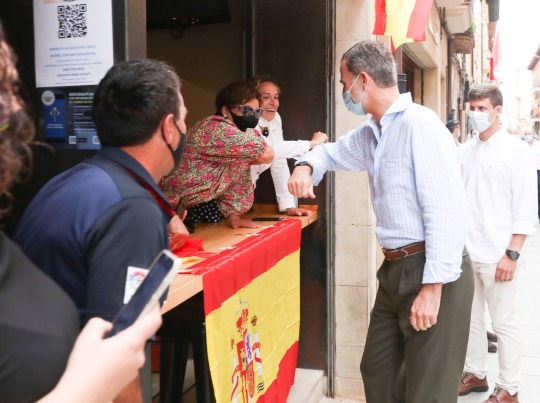
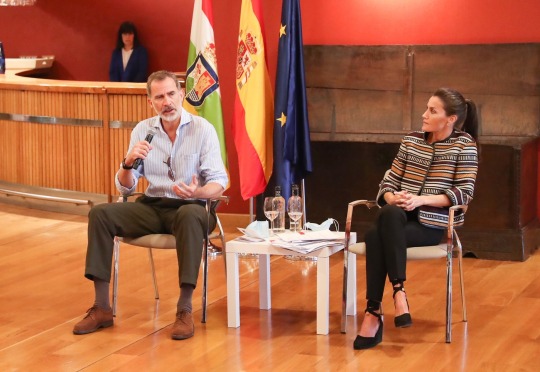

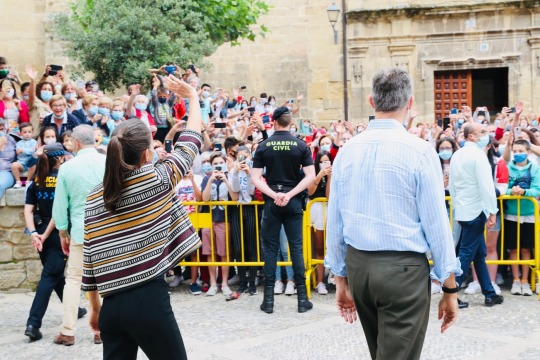


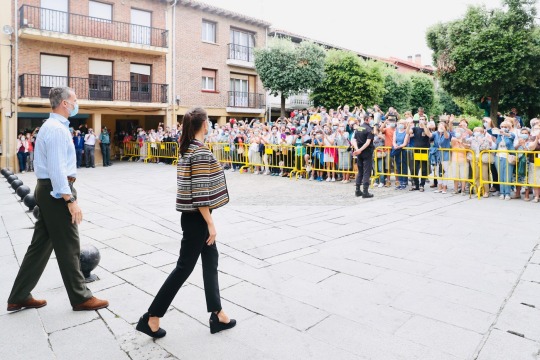
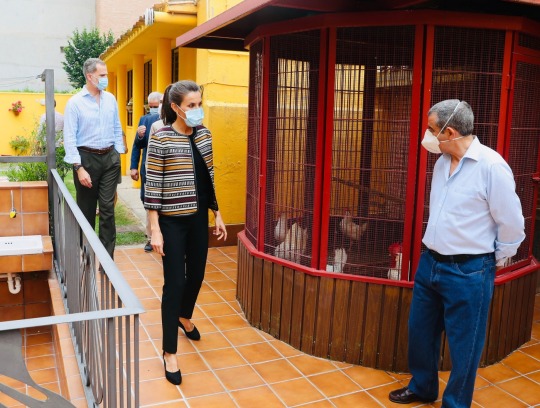
July 10, 2020: King Felipe and Queen Letizia visited the Autonomous Community of La Rioja. This was the sixth of the planned visits to all the Autonomous Communities once the state of alarm ended, to support the recovery of social, economic and citizen activity, after the pandemic.
Felipe and Letizia's visit to the Autonomous Community of La Rioja, accompanied by the Minister of Industry, Commerce and Tourism, Reyes Maroto, has begun at the Wine Station of the town of Haro, where they were received by the president of the Community Autonomous of La Rioja, Concha Andreu; the president of the Parliament of La Rioja, Jesús María García; the Government delegate in the Autonomous Community of La Rioja, María Marrodán; and the Mayor of Haro, Laura Rivado. Elena Meléndez, director of the La Rioja Wine Station and Interpretation Center has been in charge of explaining the operation of the center and the Quality Control and Instrumental Analysis and Magnetic Resonance laboratories.
As the official laboratory of the Government of La Rioja, it is a national benchmark laboratory in the wine sector, so it must have state-of-the-art technology. In this context, it provides a large number of high added-value services to the entire wine sector (physical chemical analysis, quality control of wines, microbiology, certification of origin and varieties...), with a clear innovative approach and continuous improvement in their activity.
The Haro Wine Station completed 125 years in 2017 maintaining the spirit with which it was created in 1892, the result of a need to expand into new markets and the urgency of updating Rioja winemakers on new methods of winemaking.
It is the first Winemaking Station in Spain to obtain, in October 1999, accreditation by ENAC in accordance with the International Standard EN 45001 for the vast majority of the parameters analyzed.
After this visit, Don Felipe and Doña Letizia moved to the Barrio de la Estación or neighborhood of the Haro wineries, where most of the centennial wineries of the city are concentrated. Their Majesties the Kings toured, specifically, the facilities of the oldest winery in the area Bodegas R. López de Heredia Viña Tondonia to learn about their development processes, and at the facilities of Bodegas Rioja Alta they held a meeting with the wine sector in the The Minister of Agriculture, Livestock, Rural World, Territory and Population of the Government of La Rioja, the President of the Regulatory Council of the Rioja qualified appellation of origin and those responsible for the Bodegas del Barrio de la Estación, which are the most important of the name: CVNE, Muga, Roda, López de Heredia, Bilbaínas, Gómez Cruzado,Muga or La Rioja Alta, among others.
Rafael López de Heredia founded (in 1877) the current Bodegas R. López de Heredia Viña Tondonia after a period of stay in Bayonne (France) and having maintained contact in Haro with the winemakers from Bordeaux.
It is at this time when what is known as the Station neighborhood begins to take shape, an architectural ensemble with wine as the central element, which grew with the foundation of other firms such as the Wine Company of Northern Spain (CVNE) in 1879 ; in Bodegas Gómez Cruzado (1886); Bodegas La Rioja Alta SA (1890); and the redenomination of Bodegas Bilbainas in 1901.
In the 1970s, the neighborhood added a new tenant with the arrival of Bodegas MUGA (founded in 1932 in downtown Haro). In 1987, Bodegas RODA was the last to join, building its winery at the highest end of the promontory that makes up the Station neighborhood and taking advantage of an ancient draft with more than a century of history.
To continue with the visit to the Autonomous Community of La Rioja, Don Felipe and Doña Letizia headed to Santo Domingo de la Calzada and toured this town that enters the Camino de Santiago on the Jacobean route and its Pilgrim's Hostel. And to end this trip, the Kings visited the Cathedral of Santo Domingo de la Calzada.
Santo Domingo de la Calzada is an important enclave of the Camino de Santiago. Linked to Santo Domingo —natural of Viloria— and its construction works on the Roman road, the city was born and grew from the Pilgrims Hospital that the Saint founded around the second half of the 12th century, in addition to a bridge over the river Oja to facilitate the passage of pilgrims. This hostelry fostered its growth and, later, the Jacobean route and became a key artistic, religious and economic nucleus.
#King Felipe#Queen Letizia#King Felipe of Spain#Queen Letizia of Spain#King Felipe VI#King Felipe VI of Spain#COVID-19#Official Event#Spanish Tour 2020#La Rioja 2020#July 2020
23 notes
·
View notes
Text


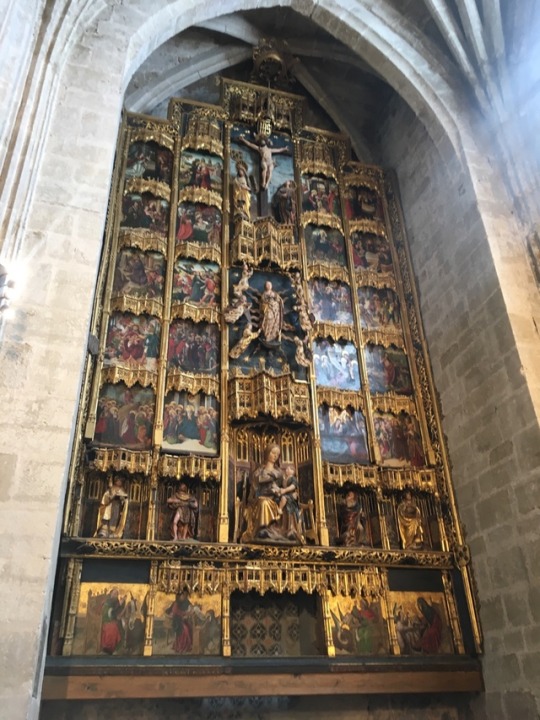

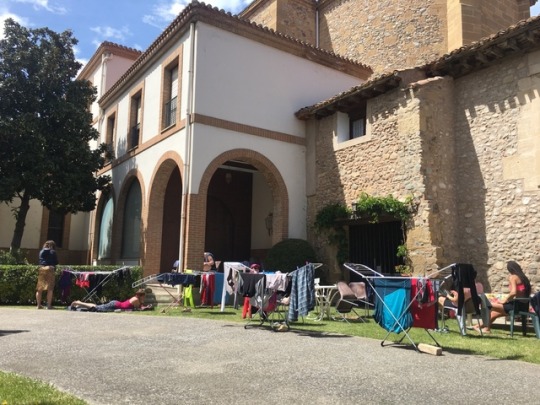

In Santo Domingo de la Calzada
Staying in an Albergue run by nuns.
This cathedral has chickens inside the cathedral. Because this town has interesting legend:
A German pilgrim couple was on their way to Santiago with their young son. They stayed a night in the mayor’s house for a night, and the daughter of the mayor fell in love with the young man. However,the young man did not care about the woman. The angry woman put a silver cup into the young man’s bag accused him of stealing it.
The penalty for the theft at the time was death by hanging. The parents went on pilgrimage to Santiago, and on their way back home stopped by to see the son’s grave to find the young man still hanging there alive. The parent ran to the mayor’s home to tell them get the young man down because he is still alive. The mayor was having a dinner of a couple of roasted chickens at the time when he was told of the young man still alive, and said “ Yeah, he is still alive like these chickens.” Then those two roasted chicken came to alive and jumped out of the roasting pan.
So there are live chickens in the cathedral because of the legend. First pic.
1 note
·
View note
Photo



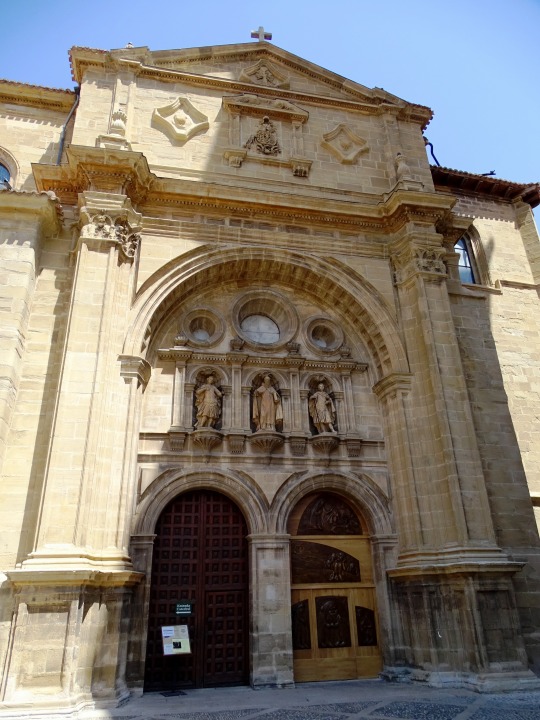


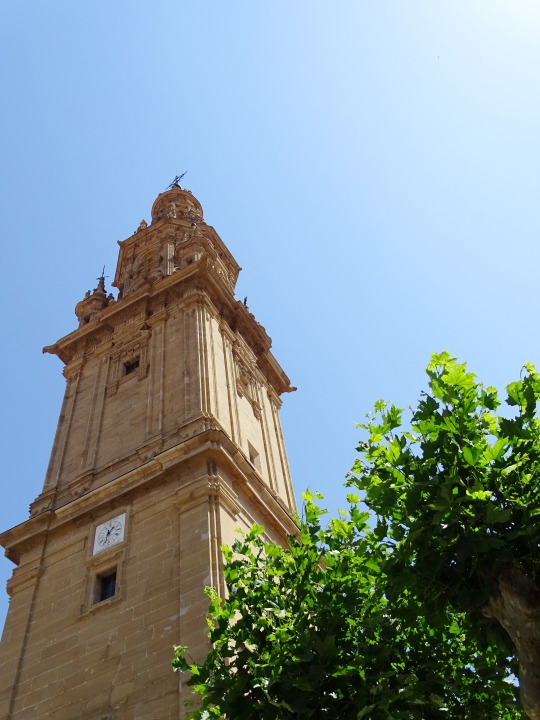



Cathedral of Santo Domingo de la Calzada, Spain (No. 2)
The building has a Latin cross plan divided into three large naves that have attached chapels. After a transept, which is marked in plan and elevation, they give in a main chapel that has, as is proper in the temples of pilgrimage, an ambulatory or ambulatory surrounded, at the same time, by different radial chapels and the outstanding central apdiole. The cloister opens to the northern side, where it is annexed to the rest of the temple.
Portada Sur
The south façade or Santo Domingo, with a large semicircular arch, which protects niches with statues of the patrons of the diocese, Santo Domingo, San Celedonio and San Emeterio) and circular oculi, was built between 1761 and 1765.
Bell Tower
The cathedral had, throughout its history, three towers. The primitive Romanesque was destroyed in a fire in 1450. The second, Gothic, had to be dismantled when threatening ruin. The third, Baroque, is the one that currently exists.
It is one of the few examples in Spain, of exempt tower (tower separated from the main body of the cathedral), is the work of the architect Martín de Beratúa under the patronage of Bishop Andrés Porras y Temas in 1762. It is of baroque style with a bell tower of the architecturally called Riojan style and, with its 70 meters high and a base of 9 meters, it is the tallest tower in La Rioja.
The legends of the place tell that the reason for the separation of the tower from the body of the cathedral is due to the fact that sandy soils were found that prevented firm foundations. In the end there was an excellent location, the current one, in which to ensure the foundations were added horns of deer and cows of the place
Source: Wikipedia
#Plaza de Santo#Portada sur#bell tower#Romanesque#Gothic#Baroque#Martín de Beratúa#Riojan style#Cathedral of Santo Domingo de la Calzada#Santo Domingo de la Calzada Cathedral#Santo Domingo de la Calzada#Spain#Camino de Santiago#Way of St James#Garçion#pilgrimage church#España#La Rioja#exterior#detail#travel#vacation#summer 2021#old town#pedestrian zone#tourist attraction#landmark#tree#architecture#cityscape
5 notes
·
View notes
Text

Rincón del claustro, catedral, Santo Domingo de la Calzada, La Rioja, 2012.
#architecture#cloister#cathedral#santo domingo de la calzada#la rioja#españa#2012#photographers on tumblr
10 notes
·
View notes
Text
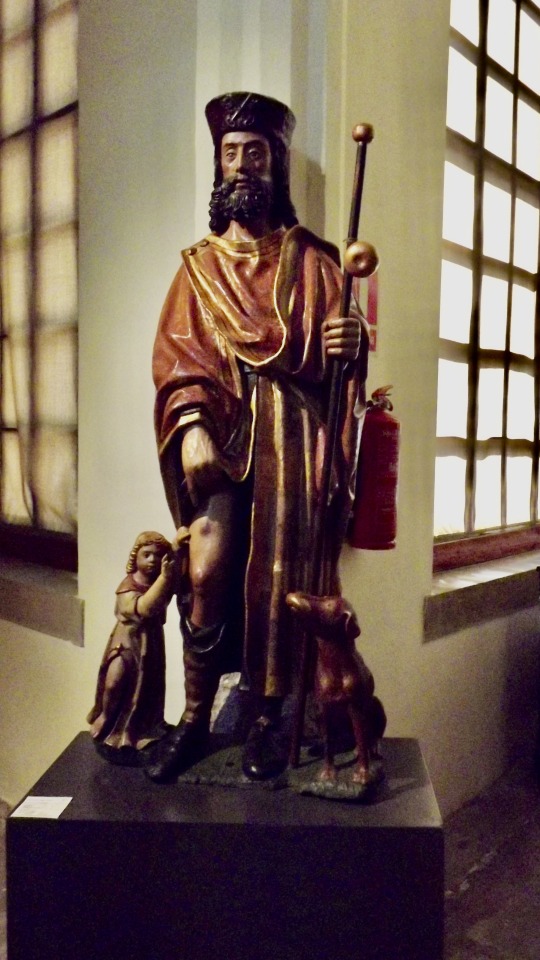
Escultura II de San Roque, catedral, Santo Domingo de la Calzada, La Rioja, 2012.
Not sure why the cathedral should have more than one image of the popular St. Roch, the patron of those suffering from plague.
#sculpture#saints#cathedral#santo domingo de la calzada#la rioja#españa#2012#photographers on tumblr#camino francés#camino santiago
0 notes
Photo
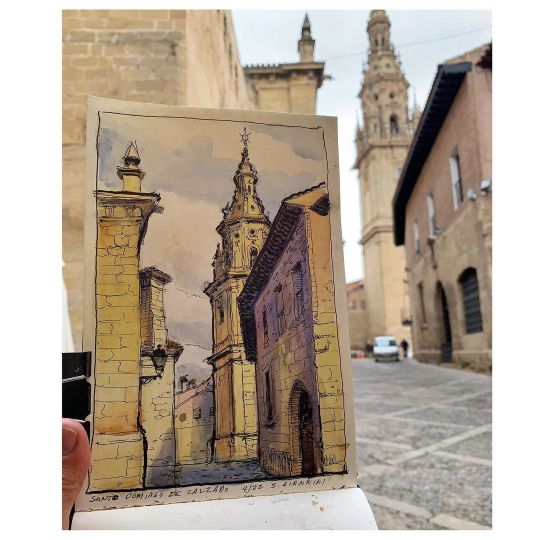
Since the last posting, I left big city Logrono, spent a night in a truckstop hotel near Najeera and then went on to Santo Domingo Calzado. This is La Riojas province, which you probably heard of from the wine you sometimes by. And indeed it’s a pastoral landscape filled with vineyards. Santo Domingo is a famous stop on the Camino Francis. Santo Domingo was a saint who specialized in helping pilgrims by improving infrastructure for them; hospitals and accommodations and bridges. The Cathedral here is gorgeous inside and out. I spent a rainy afternoon drawing outside, and the next morning I paid a five euro admission to go into the museum in church and walk up to the tower in the drawing. The church and museum are filled with beautiful artwork, and well worth a visit. I particularly enjoyed the carvings along the tops of the capitals. The tower has some exhibits on the bottom, but you can walk up about 150 steps to the bell tower, and observe the bells close up, as well as get an expansive view of the landscape around Santa Domingo. There’s a famous story here, about a chicken who came to life to prove a thief’s innocence, and actually within the Cathedral there’s a henhouse. (Here’s a link to an article with the whole story: https://caminotimestwo.com/2017/03/17/the-chickens-of-santo-domingo-de-la-calzada/ ). Unfortunately, I couldn’t see that, but I really wanted to! Not open to the public. There is rain predicted for the next two days, so we’ll see how that goes bicycling. Torre de Catedral de Santo Domingo de Calzado, 9 x 6” or 22 x 15 cm., Watercolor and ink. #santodomingodelacalzada #stillmanandbirn #portablepainter #travelsketch #caminofrances (at Catedral de Santo Domingo de la Calzada) https://www.instagram.com/p/Cc2gMmJMnj6/?igshid=NGJjMDIxMWI=
0 notes
Photo
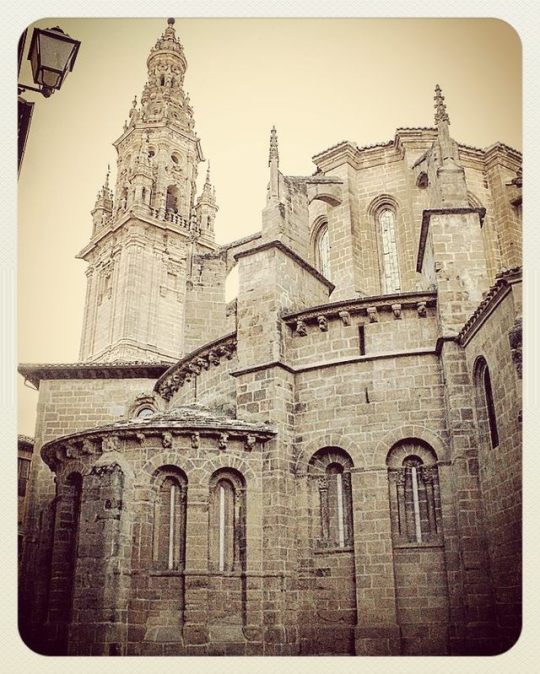
#larioja #catedral #cathedral #sepia #iglesia #church #romanico #gotico #barroco (en Santo Domingo de la Calzada)
5 notes
·
View notes
Photo
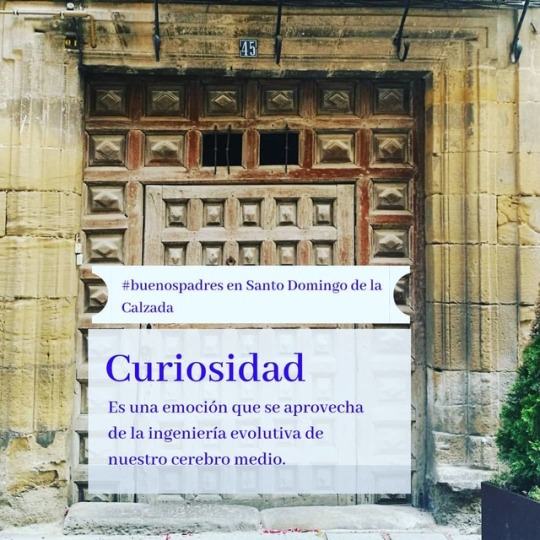
¿Qué se esconderá detrás de la historia de esta puerta? #emocionario #curiosidad #caminodesantiago #caminofrances (en Santo Domingo de la Calzada Cathedral) https://www.instagram.com/p/BzlXFIcA234/?igshid=jdtr5m02pz8h
0 notes